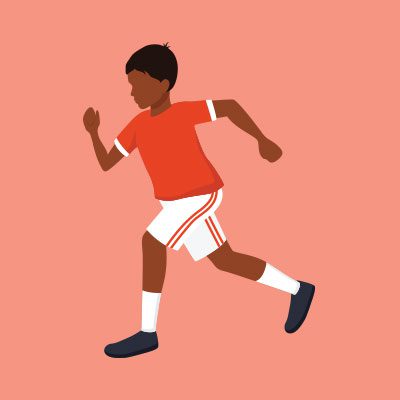
Bring the QuadSeek method to your school
OR enter your child to the Lumens way of learning.
Bring the QuadSeek method to your school
OR enter your child to the Lumens way of learning.
 Physical Development
Physical DevelopmentTo strengthen and train the child’s physical body, as well as their visual, auditory and tactile pathways.
 Intellectual Growth
Intellectual GrowthTo stimulate and build the child’s intellectual assets by developing their love for reading, learning mathematics, science, and GK.
 Emotional Balance
Emotional BalanceTo inspire and develop emotional expression and creativity.
 Spiritual Guidance
Spiritual GuidanceTo inculcate and provide a space for the child to explore and expand their self-awareness.
QuadSeek is a holistic teaching method that can work in conjunction with any curriculum or board, and it abides by the saying – “the greatest gift we can give to a child is the joy of learning, always and everywhere”. It doesn’t ask your child to learn – expecting results, it in fact, develops your child’s natural abilities to learn, resulting in making them learners for life. In other words, unlike conventional teaching methods, it goes beyond being merely instructional by engaging and developing the 4 key aspects of human personality, also allowing liberty to personalise learning for each child.
The teaching method helps teachers by involving the use of visuals, art, music, stories and real life applications in teaching any topic from pre-primary to higher secondary, which makes learning lot of fun for the children. QuadSeek thus aims to lay the foundation for a conscious, confident, sensitive and positively oriented individual, with a vast knowledge base and great values required by a desirable citizen.

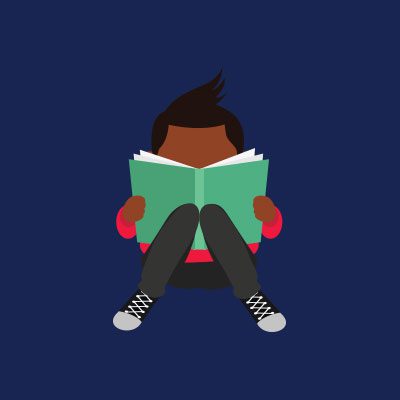
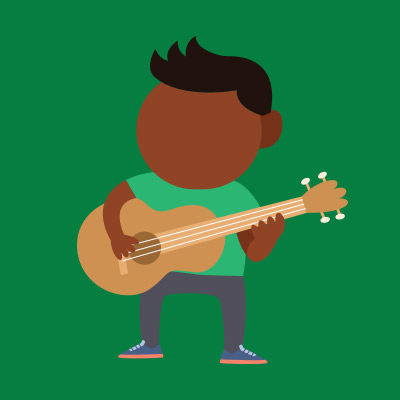
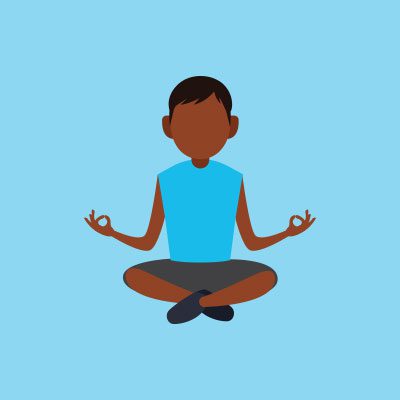
The QuadSeek Learner Profile is inspired by the philosophies of Mother and Sri Aurobindo of Pondicherry. It takes into account the natural stages of a child’s development, augmenting their growth at each stage, using a scientific approach.
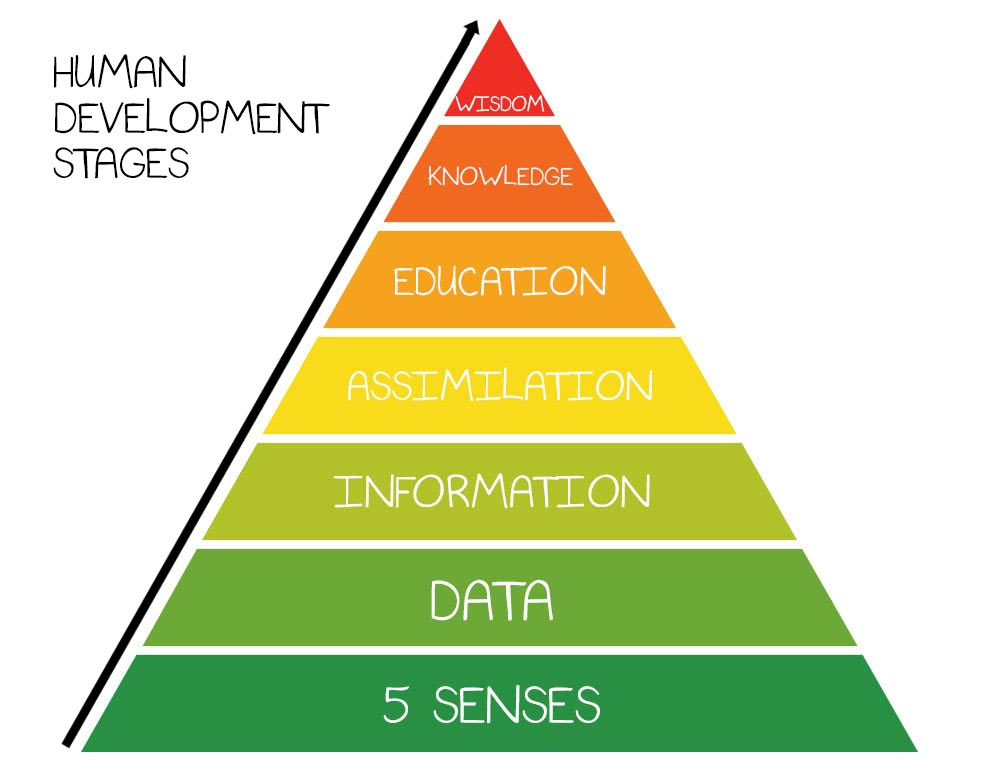
Acting from the knowledge garnered is wisdom where every action is guided by the principles acquired with cumulative benefit in perspective.
QS Factor: This is the eventual aim and the outcome.
The deep understanding of the levels below in relation to the self, the object, the creation (Trinity) and a true perception of all that is, is knowledge.
QS Factor: The singleness of origin and underlying factors linking the trinity is carefully examined and nourished in every intervention.
The sum total of values assimilated constitutes Education, which lifts the being above the level of in existence into meaningful living.
QS Factor: Every comprehension devolves into values nurtured to guide all future approaches.
The digestion of the information is assimilation, where the information blends itself into the being. This entwines into every fibre of the being making it an integral whole
QS Factor: Continuous questioning and referencing is encouraged to explore in multiple dimensions, culminating in a higher comprehension.
Processed data is information. Multiple associations linking data form the basis transcending from stage of data to ways such data may be referred and extrapolated
QS Factor: Carefully woven association webs data into meaningful configuration making decisions and extensions a reality.
Every bit of knowledge received by way of stimulation from the senses are filed away in the brain as data – each connected only when associations link them
QS Factor: Systematised sensory inputs are provided resulting in a large base of dots which would later be creatively fused.
All inputs to the brain are through the five senses. The sensors have little role but to convey the stimulation to the brain.
QS Factor: The efficiency of each receptor is enhanced by meticulous physical exercises strengthened by emotional balancers.
QuadSeek acknowledges and identifies different types of learners, providing a systematic approach that enables teachers to give individual learning opportunities to each child in a class. It even goes further and identifies the existence of a mix of all the four types in each child. Based on their personality, children prefer to learn differently. Every QuadSeek Lesson Plan is tailored to accommodate the learning preferences of each child in a class of many, thereby teaching the individual student and the class as a whole, in a more efficient and effective manner than conventional teaching methods.
The method also allows the teacher the opportunity to tackle important topics in a set of 3-4 kids at a time, teaching them at a level and pace that they are comfortable with, providing students the luxury of private tuition in the school itself. More so, each aspect of the QuadSeek teaching method is interspersed with morals, values and learning’s that attempt to develop thinking and inquiring students, as well as good human beings.
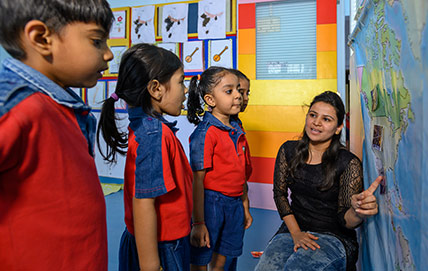
Assimilates | Intuitive | Has ability to see from above | Distancing from events
The QuadSeek Method not only adheres to different personalities of children, but it follows the natural learning process of a human being. It allows students the freedom to learn at their own pace, but it also has clearly defined outcomes on all important development aspects for each stage of a child.
Every teacher at Lumens makes at least 3 different lesson plans for each lesson. These include familiarization (i.e. new words and concepts to be introduced in the lesson) and actual delivery of the lesson and revision with the integration of all 4 aspects of the QuadSeek methodology, to ensure each child understands and enjoys the lesson.
Before the lesson begins, the children are made to familiarise with the unknown words to be used in it, through different methods, which attempts to provoke different aspects of QuadSeek in the learner. This ensures individual attention to each student.
The reason for doing so is that each child is bound to have a different kind of aptitude and so the preference for learning is based on the dominant aspect of their being i.e. the physical, the spiritual, the intellectual or the emotional aspect. It is imperative to utilize and augment this inclination, in order to make learning easy and joyful for the child.
Class Structure:
From any small time school to IIT, IIM or Harvard, each class (in fact each subject) has its exceptionally bright students (that are quick to understand what is taught), the ones that are mildly interested and the ones that find it really hard to even get the basics right.
 In most cases such as this, a teacher teaches a lesson expecting all of the above 3 categories to learn at one go, at the same speed. This in turn, draws one or the other category further away from the topic. In Lumens each class will have an individual library and Laboratory, which would always be stocked with books and tools related to the topic taught by the teacher. So in a typical class, where the teacher finds students that understand the lesson easier than others, he/she would move that group to the library corner and give them some more advanced/ challenging tasks to do, using books or other TLM. The laboratory is used to explain topics in a practical manner. This arrangement ensures maximum learning for each child to the best of their interest and calibre.
In most cases such as this, a teacher teaches a lesson expecting all of the above 3 categories to learn at one go, at the same speed. This in turn, draws one or the other category further away from the topic. In Lumens each class will have an individual library and Laboratory, which would always be stocked with books and tools related to the topic taught by the teacher. So in a typical class, where the teacher finds students that understand the lesson easier than others, he/she would move that group to the library corner and give them some more advanced/ challenging tasks to do, using books or other TLM. The laboratory is used to explain topics in a practical manner. This arrangement ensures maximum learning for each child to the best of their interest and calibre.
 Also, at Lumens we have a format of just 26 students per-class, and students are taught in groups of three or four based on their attributes and inclinations. Due to this, our teacher-student ratio is high, in order to ensure each student gets individual attention.
Also, at Lumens we have a format of just 26 students per-class, and students are taught in groups of three or four based on their attributes and inclinations. Due to this, our teacher-student ratio is high, in order to ensure each student gets individual attention.
Alternative Teaching Methods:
We also make children from the higher standards teach those from the lower standard (e.g. 4th and 3rd standard). This won’t just help them understand the subjects even better, but it will also inculcate team work and empathy within them.
At this level we begin with FUN-IN-LEARNING techniques, to help the child familiarize with the world around, and to see the inter-play of the things that surround him/her. We do this through games, story-telling, puppets, narratives, play acting etc. in order to allow the child to set the pace and lead on, while feeling no pressure.
This stage of our schooling focuses on developing the child physically, emotionally and intellectually. The objective behind doing so, is to build a strong base for the child to grow in a conscious, concise and systematic manner. We deliberately don’t divide what the children learn into subjects at this point, except for into – language, mathematics and general knowledge – while organizing activities.
Our Method:
The human brain grows between the ages 0 to 6 years, and a child is also the most curious during this period, which makes it the best time for learning. Thus, this is where we first introduce the ‘Quad-Seek’ method to our children, to ensure an all-round growth in them.
Our Physical Programme focuses on aiding the development of the brain and fine tuning the sensory organs, to prepare the mind and body for better learning. It includes –
| Creeping- Enhances motor co-ordination and growth of the mid brain | Crawling– Enhances Pons & reflex organs |
| Brachiating – Enhances growth of lungs for better supply of oxygen | Climbing – Enhances depth perception |
| Balance beam walking – To enhance balance and convergence of vision | Walking/Running – Enhances clear speech and long sessions of concentrated work |
Our Intellectual programme simultaneously helps stimulate the sharpened minds, by offering vast amounts of knowledge to their immense curiosity. It includes –
The Reading program: Children learn words through continuous interaction with teachers and flash cards, flashed with planned frequency. Through knowledge of words and stories, interest in reading is cultivated.
The Math Program: This includes the learning of numbers, sequence and basic arithmetic functions.
The IKP Program: It ensures that children learn –
Our emotional programme helps balance out any draining of the self – physical or intellectual activities may cause, by weaving daily schedules with activities like –
| Stories | Art/ craft |
| Plays | Music |
Our spiritual programme aims to ensure that amidst their acquirement of knowledge and intellectual growth, our
children also learn to be sensitive, respectful and contributing members of society. We do so by –
At the end of our Pre-Primary program (by the age of 5 ½, if program is begun at 3 years of age), children can –
This is the transition level where children move out into an interim stage where the foundation laid in the pre-school is leveled and strengthened in preparation for the super structure of the K-12 curriculum.
Language:
The general objectives at this level are:
At the end of this stage learners should be able to –
Math:
The general objectives at this level are:
At the end of this stage learners should be able to –
At this level there may not be enough conceptual basis for any clear demarcation of physical and social sciences, but it could be possible to introduce ways of looking at the social and natural world in the form of activities, ways of data collection, and making sense out of them. Elements of daily life would be familiarised in the context of hygiene and cleanliness of surroundings; reaching out from the immediate environs to widening circles to discover simple aspects of the universe. Hands-on simple experiments in physical and social sciences will be conducted.
Language:
The general objectives at this level are:
At the end of this stage learners should be able to –
Though it may yet be early to demarcate study of various sciences, aspects of each nonetheless would have been enhanced through observation and experimentation. Children would be exposed to hands-on science through learning-through-doing approaches. The stress here would be to ensure that the student has a wide knowledge base both empirical and experiential in readiness for the next level of learning.
Math:
The general objectives at this level are:
At the end of this stage learners should be able to –
This is the time to build on the secure foundation laid in the 10 earlier years, equipped with a strong base of general information, a well-developed skill in reading and comprehension and strong proficiency in math. Added to it would be a grounded sense of practical exposure to laboratories and competence in computer literacy.
The learner would imbibe the skill of thinking an idea through looking at a problem from varied perspectives and being able to hypothesise, analyse, apply his garnered knowledge and conclude in areas within experience thinking an idea through with capacity to conceptualise from varied viewpoints. The student would display a marked ability to make decisions, after quick surgical examination of perspectives and enquiry into the situation tempering logic with empathy and understanding of stake-holders
The student would have a complete understanding in the first language with premium oral skills, an ability to read fluently and process seamlessly to understand intricate nuances and frame grammatically orderly and cohesive sentences. The pupil would in the second language, be able to process while reading comfortably with complete understanding and show a fair familiarity at the basics with a third.
He would show focus, coherence and discerning independence while being able to merge into roles in team-work to achieve goal directed results. The student would exhibit strong sense of values while not shying away from bold and innovative decisions. The student would perform excellently in the proficiencies of Literacy in Technology and Information, Curricular Literacy, Logical Reasoning, Oral and Written Communication, Independence in thinking as well as collaborative working.
This is the culminating stage of school education where the student would have garnered the fundamentals in a wide variety of subjects in preparation to moving to areas of acquiring specialised knowledge and skills.